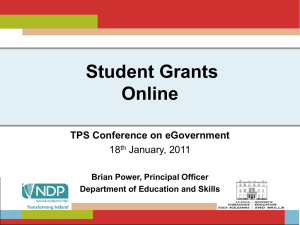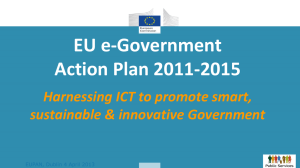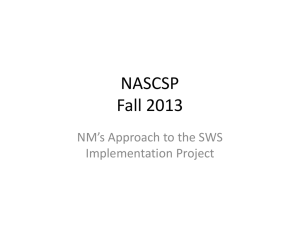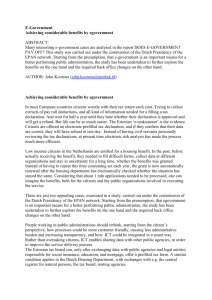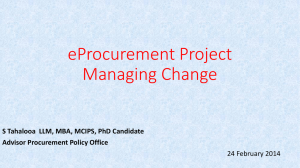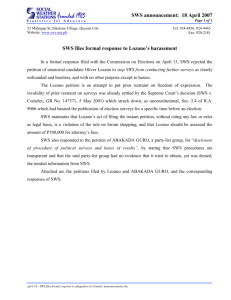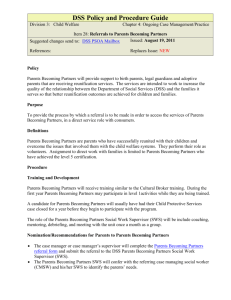SWS application areas in eGovernment - DIP
advertisement
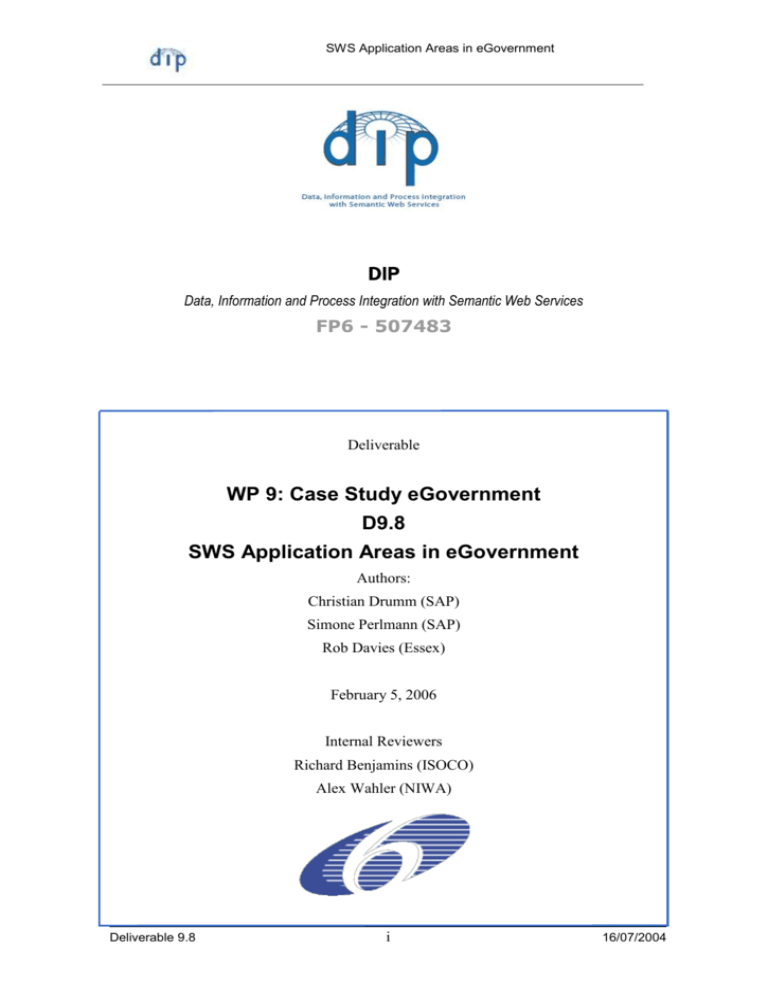
SWS Application Areas in eGovernment DIP Data, Information and Process Integration with Semantic Web Services FP6 - 507483 Deliverable WP 9: Case Study eGovernment D9.8 SWS Application Areas in eGovernment Authors: Christian Drumm (SAP) Simone Perlmann (SAP) Rob Davies (Essex) February 5, 2006 Internal Reviewers Richard Benjamins (ISOCO) Alex Wahler (NIWA) Deliverable 9.8 i 16/07/2004 SWS Application Areas in eGovernment SUMMARY The purpose of this deliverable is to identify further potential application areas for Semantic Web Services in eGovernment scenarios. Besides the two scenarios, namely “Change-of-Circumstance” and “GIS”, which have already been investigated in this workpackage, eGovernment offers a large variety of processes, SWS could beneficially be applied to. In order to identify further SWS application areas in the area of eGovernment the following report investigates different basic services and illustrates how they could be improved by using Semantic Web Services (SWS). Specific emphasis will be placed on public eProcurement. Disclaimer: The DIP Consortium is proprietary. There is no warranty for the accuracy or completeness of the information, text, graphics, links or other items contained within this material. This document represents the common view of the consortium and does not necessarily reflect the view of the individual partners. Deliverable 9.8 ii 16/07/2004 SWS Application Areas in eGovernment Document Information IST Project Number FP6 – 507483 Full title Data, Information, and Process Integration with Semantic Web Services Project URL http://dip.semanticweb.org Acronym DIP Document URL EU Project officer Kai Tullius Deliverable Number 9.8 Title SWS Application Areas in eGovernment Work package Number 9 Title Case Study eGovernment Date of delivery Contractual M 24 Status Actual 31-Dec-05 final version. 1.0 Nature Prototype Report Dissemination Ontology Dissemination Level Public Consortium Authors (Partner) Christian Drumm (SAP), Rob Davies (Essex CC), Simone Perlmann (SAP) Responsible Author Christian Drumm Email Partner SAP Phone +49-721-690278 christian.drumm@sap.com Abstract Identify further potential application areas for Semantic Web Services in (for eGovernment scenarios. dissemination) Keywords eGovernment Semantic Web Services Version Log Issue Date Rev No. Author Change 02-09-2005 001 Christian Drumm Created initial version of the document 10-12-2006 002 Rob Davies Final version Deliverable 9.8 iii 16/07/2004 SWS Application Areas in eGovernment Project Consortium Information Partner Acronym NUIG Contact Prof. Dr. Christoph Bussler Digital Enterprise Research Institute (DERI) National University of Ireland, Galway National University of Ireland Galway Galway Ireland Email: chris.bussler@deri.org Tel: +353 91 512460 Bankinter Monica Martinez Montes Fundacion de la Innovation. BankInter Paseo Castellana, 29 Fundacion De La Innovacion.Bankinter 28046 Madrid, Spain Email: mmtnez@bankinter.es Tel: 916234238 Berlecon Dr. Thorsten Wichmann Berlecon Research GmbH Oranienburger Str. 32 Berlecon Research GmbH 10117 Berlin, Germany Email: tw@berlecon.de Tel: +49 30 2852960 BT Dr John Davies BT Exact (Orion Floor 5 pp12) Adastral Park Martlesham British Telecommunications Plc. Ipswich IP5 3RE, United Kingdom Email: john.nj.davies@bt.com Tel: +44 1473 609583 EPFL Prof. Karl Aberer Distributed Information Systems Laboratory École Polytechnique Féderale de Lausanne Swiss Federal Institute of Technology, Lausanne Bât. PSE-A 1015 Lausanne, Switzerland Email : Karl.Aberer@epfl.ch Tel: +41 21 693 4679 Essex Mary Rowlatt, Essex County Council PO Box 11, County Hall, Duke Street Essex County Council Chelmsford, Essex, CM1 1LX United Kingdom. Email: maryr@essexcc.gov.uk Tel: +44 (0)1245 436524 FZI Andreas Abecker Forschungszentrum Informatik Haid-und-Neu Strasse 10-14 Forschungszentrum Informatik 76131 Karlsruhe Germany Email: abecker@fzi.de Tel: +49 721 9654 0 Deliverable 9.8 iv 16/07/2004 SWS Application Areas in eGovernment Partner Acronym UIBK Contact Prof. Dieter Fensel Institute of computer science University of Innsbruck Institut für Informatik, Leopold-Franzens Universität Innsbruck Technikerstr. 25 A-6020 Innsbruck, Austria Email: dieter.fensel@deri.org Tel: +43 512 5076485 ILOG Christian de Sainte Marie 9 Rue de Verdun, 94253 Gentilly, France ILOG SA Email: csma@ilog.fr Tel: +33 1 49082981 Inubit Torsten Schmale inubit AG Lützowstraße 105-106 inubit AG D-10785 Berlin Germany Email: ts@inubit.com Tel: +49 30726112 0 iSOCO Dr. V. Richard Benjamins, Director R&D Intelligent Software Components, S.A. Pedro de Valdivia 10 Intelligent Software Components, S.A. 28006 Madrid, Spain Email: rbenjamins@isoco.com Tel. +34 913 349 797 NIWA Alexander Wahler NIWA WEB Solutions Niederacher & Wahler OEG NIWA WEB Solutions Kirchengasse 13/1a A-1070 Wien Email: wahler@niwa.at Tel:+43(0)1 3195843-11 | OU Dr. John Domingue Knowledge Media Institute The Open University, Walton Hall The Open University Milton Keynes, MK7 6AA United Kingdom Email: j.b.domingue@open.ac.uk Tel.: +44 1908 655014 SAP Dr. Elmar Dorner SAP Research, CEC Karlsruhe SAP AG SAP AG Vincenz-Priessnitz-Str. 1 76131 Karlsruhe, Germany Email: elmar.dorner@sap.com Tel: +49 721 6902 31 Deliverable 9.8 v 16/07/2004 SWS Application Areas in eGovernment Sirma Atanas Kiryakov, Ontotext Lab, - Sirma AI EAD Office Express IT Centre, 3rd Floor Sirma AI Ltd. 135 Tzarigradsko Chausse Sofia 1784, Bulgaria Email: atanas.kiryakov@sirma.bg Tel.: +359 2 9768 303 Unicorn Jeff Eisenberg Unicorn Solutions Ltd, Malcha Technology Park 1 Unicorn Solution Ltd. Jerusalem 96951 Israel Email: Jeff.Eisenberg@unicorn.com Tel.: +972 2 6491111 VUB Pieter De Leenheer Starlab- VUB Vrije Universiteit Brussel Vrije Universiteit Brussel Pleinlaan 2, G-10 1050 Brussel ,Belgium Email: Pieter.De.Leenheer@vub.ac.be Tel.: +32 (0) 2 629 3749 Deliverable 9.8 vi 16/07/2004 SWS Application Areas in eGovernment LIST OF KEY WORDS/ABBREVIATIONS CRM Customer Relationship Management eGIF eGovernment Interoperability Framework (UK) ERP Electronic Resource Planning GIS Geographical Information System SOAP Simple Object Access Protocol SWS Semantic Web Service UDDI Universal Description, Discovery and Integration WSMO Web Service Modelling Ontology XML Extensible Markup Language XSD XML Schema Deliverable 9.8 vii 16/07/2004 SWS Application Areas in eGovernment TABLE OF CONTENTS SUMMARY ......................................................................................................................... II LIST OF KEY WORDS/ABBREVIATIONS ........................................................................ VII TABLE OF CONTENTS ................................................................................................... VIII 1 INTRODUCTION .............................................................................................................. 1 2 CURRENT DEVELOPMENTS IN EGOVERNMENT ............................................................ 1 3 SWS IN EGOVERNMENT: KEY FINDINGS ..................................................................... 2 4. APPLICATION AREA CASE STUDY: EPROCUREMENT AND CATALOG-MANAGEMENT IN EGOVERNMENT ............................................................................................................ 7 4.1. 1 Detailed Scenario Description – an eGovernment lighthouse project in Hesse, Germany ........................................................................................................ 9 4.1.2 Current Limitations ....................................................................................... 11 4.1.3 Technical interoperability between systems (Data interoperability) ............. 12 4.1.4 Semantic interoperability (Product classification) ........................................ 13 4.1.5 Recent market solutions ................................................................................ 13 4.1.6 Potential Application of SWS ....................................................................... 15 4.1.7 Expected Benefits .......................................................................................... 16 5 CONCLUSION ............................................................................................................... 16 REFERENCES .................................................................................................................. 17 ANNEX A – SURVEY QUESTIONNAIRE ........................................................................... 18 LIST OF FIGURES Figure 1: eProcurement in Hesse ...................................................................................... 9 Figure 2: The eProcurement process in Hesse ............................................................... 10 Figure 3: Challenges of supplier enablement ................................................................. 11 Figure 4: Catalogue management needs ......................................................................... 13 Figure 5: Converting Data .............................................................................................. 14 Figure 6: Challenges to eProcurement success............................................................... 14 LIST OF TABLES Table 1: Basic eGovernment services .............................................................................. 1 Deliverable 9.8 viii 16/07/2004 FP6 – 507483 Deliverable 9.8 1 INTRODUCTION The purpose of this deliverable is to identify potential application areas for Semantic Web Services in the area of eGovernment. Besides the two scenarios, namely “Changeof-Circumstance” and “GIS”, which have already been investigated in this workpackage, eGovernment offers a large variety of further processes, SWS can beneficially be applied to. The document is organised as follows: firstly we provide a general high-level overview on the current developments in eGovernment. After this we will present the results of a survey we conducted with projects and organisations active in research in the eGovernment area across Europe and discussions we had with numerous eGovernment practitioners. Finally we will pick one of the identified application areas, namely eProcurement, and investigate it in more detail, focusing on possible applications of SWS as well as on the expected benefits. 2 CURRENT DEVELOPMENTS IN EGOVERNMENT Especially over the last years, significant developments have been taken place in transforming public services into electronic services. Meanwhile, ICT strongly supports internal processes of European governments and their local authorities as well as the delivery of government products and services to public administrations (G2G), businesses (G2B) and citizens (G2C). Although some of those government products and services appear very specialized or unique to the demands of government, others are the same or similar to those in private eBusiness sector e.g.: Electronic service delivery: via citizen/enterprise web portals, citizen/enterprise call centers, electronic IDs, and digital signatures or Electronic procurement: Electronic Catalogs, electronic tendering platforms According to a study of Capgemini [2005] the following basic public services are currently being offered by European governments: Table 1: Basic eGovernment services1 Basic G2C Services Income taxes Job search Social security benefits Personal documents Car registration 1 Basic G2B Services Social contribution for employees Corporate tax VAT Registration of a new company Submission of data to the statistical office Custom declaration Environment-related permits Public procurement Applications for building permission Declaration to the police Public libraries Birth and marriage certificates Capgemini: Online availability of public services: How is Europe pressing, March 2005 1 FP6 – 507483 Deliverable 9.8 Enrolment in higher education Announcement of moving Health-related services In order to identify further SWS application areas in the area of eGovernment the following report provides an illustrative analysis of the results of an investigation of different basic services and illustrates how they could be improved by using Semantic Web Services (SWS). The results have been drawn from several activities conducted by WP9 duriung the period October 2005-January 2006, including: an in-house invstigation and consultation conducted with the SAP Product Group in Germany; a survey conducted by Essex County Council involving a number of projects and organisations active in leading edge research in the eGovernment area across Europe (see Annex A – Survey Questionnaire); a Focus Group involving a number of invited eGovernment practitioners in the United Kingdom, organised in Essex on 7 January 2006. Specific emphasis is placed on public eProcurement as an illustrative application area in which demand is indicated (see section 4). This deliverable should therefore been seen as a staging post on the way to the final deliverable of WP9. D9.16 - Summative report on potential applications of SWS in egovernment: featuring a cost-benefit case, analysis of outstanding issues and recommendations on next steps. 3 SWS IN EGOVERNMENT: KEY FINDINGS In this section we will first summarise the general findings that are the result of our survey and the focus group discussions. These investigations addressed the following list of questions (bold italics) through structured discussion and were specifically designed to elicit the views of stakeholders (IT managers, researchers, IT suppliers) in the eGovernment field. What use is being made of Web Services in eGovernment applications? For what purposes are Web Services being used? Some local authorities are beginning to move towards service-oriented architectures and in the process introducing Web services. Where this is so, it is often the case that integration strategies and deployment of Web services are primarily internal, but this may be linked to an intention to connect internal systems to external services e.g. for payments and to deploy Web services and semantics in external applications. But even where this is so, future strategies are not always well-established. In the United Kingdom, central government agencies such as the National Health Service2 have made some of their data sources (directories of doctors, dentists etc) available as Web services ONLY, mainly on grounds of cost reduction by avoiding maintenance of more than one data copy. 2 http://www.nhsonline.net/ 2 FP6 – 507483 Deliverable 9.8 Are Web Services standards (WSDL, UDDI, SOAP etc) being deployed? These standards are mandated in the United Kingdom as part of the eGovernment Interoperability Framework (eGIF)3. SOAP and XML are widely deployed. But authorities may not, for example, be at a stage where UDDI is used What are the barriers to deployment of Web Services in eGovernment? A number of inter-related barriers emerged including: Trust in data sharing. Many departments and services often still prefer to maintain their own copy of data rather than rely upon a continuously updated external data source. Large numbers of databases are maintained which hold similar data (e.g. property addresses may be held in over 100 databases per local authority) held in inconsistent formats. The consequences of this are exacerbated in ‘cross-border’ projects. It can be difficult to persuade service departments that it is safe to use Web Services, for example opening up firewalls for Web Services is often seen as a problem. Gaining the confidence of different authorities to plug into a common secure network can be problematic, especially where provision is outsourced. Buy-in to the ‘modularisation’ of services raises concerns about ownership and control among individual service providers. Levels of awareness remain rather patchy. Some IT suppliers do not know what a Web Service is. There is still confusion between Web Services, as technically defined, and general ‘services’ available via the Web. Market development is needed. Many IT service suppliers to government do not yet use Web Services. There is a need to sell the business case at strategic level. The bigger picture of potential benefits for the authority as a whole is lacking. Infrastructure costs (such as investment in Web Services) are seen as expensive up front: there is a reluctance to be the pioneer department which has to take the initial financial ‘hit’ Is there awareness of current developments in Semantic Web Services (including WSMO)? Respondents to the survey were increasingly aware of the emerging importance of adding semantics to eGovernment systems, but were not aware of any specific developments which deployed SWS or WSMO. 3 http://www.govtalk.gov.uk/schemasstandards/egif.asp 3 FP6 – 507483 Deliverable 9.8 What are the perceived implications of SWS concepts for eGovernment. In which application or service areas might they be most effective? Numerous eGovernment areas were identified, such as school admissions, libraries, health and child care are seen as potentially promising for SWS application area. An SWS system in Children’s Services, dealing with issues such as identity management, authentication, common descriptors/ontologies (for example covering types of child minding services), where many different types of service and agency (social care, children’s services, police etc) have to be pulled together to assess whether a child is ‘at risk’, was seen by DIP respondents in the UK as a potentially promising area for piloting SWS. Related ‘Cross-border’ issues (i.e. between neighbouring local authorities) were an additional aspect identified. An SWS approach could lead to less central direction and facilitate the development of regional models suited to more localised needs. An end user-centred ‘problem-solving’ approach (e.g. ‘Life Events’) might particularly benefit from SWS. Work done in the area of bereavement services (in Birmingham) was cited as one example of this. General argumentation for the benefits of SWS often centred on ‘utility computing’ models: a future in which it would no longer be necessary to maintain departments and services such as IT, payroll etc in-house An additional benefit would lie in the ability to enable different organisations to perform different parts of a broad task in a distributed fashion, thereby allowing services to be aggregated on the basis of different user preferences. Are there any other current efforts to prototype future applications using SWS in eGovernment? Little evidence was discovered of such developments outside the academic research sector. What projects or initiatives are aiming to achieve integration across different applications or across agency boundaries? What are the integration technologies used in these projects? What kind of integration problems are being addressed through such developments? How might SWS help? There is a readily-evident and substantial demand at the strategic planning and service delivery levels for improved access to (and discovery of) aggregated data, for purposes ranging from overview, comparison to decision-making in specific cases. In the United Kingdom, some 30 e-Government National Projects have been funded by government in the period up to 20054. They address a wide range of application integration areas. One of the major projects has been in the area of eProcurement (NEPP)5 4 http://www.localegovnp.org.uk/. 5 http://www.localegovnp.org.uk/ 4 FP6 – 507483 Deliverable 9.8 Regional agencies such as London Connects6, are trying to give London’s 33 local authorities a single face by pooling information from all of them through a London Portal to the benefit of the authorities and their citizens. Projects such as Valuebill7 managed by Newham (London) are now being rolled out by London Connects, and are attempting to integrate access to suppliers. Essex County Council sees SWS as a potential means of adding value to ‘traditional’ GIS services, for example by providing information on school closures in the event of an emergency The Pan-London School Admissions8 national project led by the London Borough of Wandsworth was all about data sharing and integration between 33 London boroughs in order to address problems of over subscription etc to individual schools. SWS services could provide a promising future pathway, which agencies such as London Connects could be interested to incorporate in their ‘roadmap’ From many of these projects it had emerged that integration of addresses in different formats would have a very wide benefit. Are there applications/processes that it is not feasible to implement using current technologies. Why is this and how might SWS affect these? Sharing and trust is a problem even for addresses. Birmingham has 70 major systems and many hundreds of smaller ones, no two of which are the same. Demonstrating that SWS have the capacity to streamline in this area could be an important benefit. What is the best route to standardisation and takeup of SWS for the eGovernment sector in the UK? A favourable alignment of three conditions is needed to enable take-up of any new technology: 1. Clear statement of business problem addressed: what the benefit is. 2. Maturity of technology 3. Standards Business Case Take-up can be further enhanced by focusing marketing efforts on the point where the impact of integration appears ‘on the surface’, by concentrating on areas where change is already happening (such as GIS) and also areas in which local partnerships between agencies are needed. Government authorities will need usually to establish a measurable benefit to service plus realisable cost savings, or ‘cashable benefits’ after 1 year and then in subsequent years, although there is frequently a perceived cynicism about such calculations Corporate level investment planning is needed to ensure adoption: therefore be ‘sold’ at corporate level 6 www.londonconnects.gov.uk/ 7 apps.newham.gov.uk/valuebill/ 8 www.localegovnp.org/default.asp?sID=1095851387925 5 SWS should FP6 – 507483 Deliverable 9.8 The business case/selling point for SWS may include: • Increasing ability to share costs • Solving integration/interoperability problems (e.g. reducing the 2.5K websites currently produced by local government in the UK) and lowering the cost of doing so. Maturity of Technology There are no real examples of SWS in eGovernment beyond the DIP prototypes. A key issue is the speed with which SWS will become available for deployment and how they will be deployed? It seems likely that, to begin with, solutions will appear in vertical domains such as the travel sector. Products such as SAP NetWeaver will become available in those sectors and will integrate SWS. The proposed open implementation of the DIP reference architecture will be important potentially in encouraging new suppliers In the next year or two, standards may emerge to provide ’grounding’ for the description of services in a simple ontological fashion. It may become possible to use parts of this in e.g. public-facing discovery systems. In eGovernment, SWS should be conceived as selling an approach or an architecture which may be applicable to particular application areas e.g. CRM, GIS. Standards Xml is an important market driver which many suppliers are behind and provides an example of how SWS standards take-up would need to be driven. Mechanisms for adoption of new standards and change control mechanisms are needed for standards applicable in eGovernment as in any other area. In the UK • the e-Government Unit (EGU)9 at the Cabinet office • and the eGovernment Interoperability Framework (eGIF) have a key role but are seen by many as relatively weak, under-resourced mechanisms. • The Local eGovernment Standards Body (LeGSB) 10 in itself a National Project, will not be sustained and has now been closed. There is a limited audience within eGovernment for W3C and OASIS-based standards. Standardisation takes a long time through te national standards institution. This combination of conditions presents a problem for the adoption of SWS standards in eGovernment. In the UK, it would currently be necessary to persuade one or more central government departments to ‘sponsor’ a proposal for new standards. 9 http://www.cabinetoffice.gov.uk/e-government/ 10 http://www.localegovnp.org.uk/ 6 FP6 – 507483 Deliverable 9.8 A Council of Chief Information Officers (CIOs) has been established but with only two local government representatives, whom it would be necessary to lobby successfully to achieve action (they are not directly accountable to the local government community). A group of Chief Technical Officers (TCOs) has been established under them. There is also an Interoperability Working Group. Representation is skewed towards central government departments. Fundamental issues concerning eGovernment standards in the UK include: an absence of sanctions on non-compliance (nothing is mandatory) and unsatisfactory human networking mechanisms. Only a limited ‘core’ of local government IT people is ‘in communion’ with the Office of the Deputy Prime Minister (ODPM), the government department responsible. Effective dissemination of developments beyond that group is also limited. At European Level, CEN/ISSS11 and the IDABC e-Government Working Group12 are potentially important routes to the adoption of standards visible to the eGovernment sector. The people active in these groups need to be convinced of the actual benefits for the delivery of eGovernment services to be gained by adopting WSMO. Change needs to happen through people working together, leading to the emergence and adoption of .appropriate and robust standards. It will be important to build confidence, demonstrate capability, by demonstrating systems that can do simple things well and straight away. 4. APPLICATION AREA CASE STUDY: EPROCUREMENT AND CATALOGMANAGEMENT IN EGOVERNMENT As eProcurement and Catalog-Management in eGovernment appears to be one of the most promising application areas. The remainder of this Deliverable is dedicated to this area. The initial discussion will focus on the current processes and the involved stakeholders. In a second step, we will highlight the current limitation of this scenario followed by a brief discussion on how SWS could be used to implement the described scenario. Most large Western European central governments already have built, or are in the process of building eProcurement platforms. This does not reflect specialized or unique governmental demand in general, but a demand also valid for the private sector, it seems to be highly suitable to ensure a widespread exploitation into different market segments. Furthermore, most large Western European central governments have built, or are in the process of building eProcurement platforms (see section 3.1.1 as an example). They are actually in need of a continued support for maintenance and upgrading to full transactional functionalities, including not only publication of tenders or online eCatalogs, but also fully online eTendering solutions13. In general, public eProcurement (electronic Procurement) enables governments to do business-to-business purchase on the one side and sale of supplies and services on the 11 www.cenorm.be/isss/ 12 http://europa.eu.int/idabc/ 13 http://www.idc.com/getdoc.jsp?containerId=PP09M 7 FP6 – 507483 Deliverable 9.8 other side. Typically, eProcurement allows qualified and registered users to look for buyers or sellers of goods and services. Depending on the approach, buyers or sellers may specify prices or invite bids. Transactions can be initiated and completed. Ongoing purchases may qualify customers for volume discounts or special offers. Public eProcurement by electronic means improves and simplifies the way government procurement operates.14 Generally, there are six main types of eProcurement:15 Web-based ERP (Electronic Resource Planning): Creating and approving purchasing requisitions, placing purchase orders and receiving goods and services by using a software system based on Internet technology. e-MRO (Maintenance, Repair and Operating): The same as web-based ERP except that the goods and services ordered are non-product related MRO supplies. e-sourcing: Identifying new suppliers for a specific category of purchasing requirements using Internet technology. e-tendering: Sending requests for information and prices to suppliers and receiving the responses of suppliers using Internet technology. e-reverse auctioning: Using Internet technology to buy goods and services from a number of known or unknown suppliers. e-informing: Gathering and distributing purchasing information both from and to internal and external parties using Internet technology. Moreover, eProcurement in Governments supports multiple purchasing methods such as e-shops, online auctions or e-marketplace to buy the variety of goods and services required by public administrations. It offers the following benefit: Cost reduction and budget transparency Increased efficiency in requisitioning and approving, purchasing and accounts payable across the entire organization Improved ownership and accountability of procurement outcomes Best practice or syndicated procurement Benchmark and measurement of procurement performance Improved buying practice thereby enabling strategic sourcing and improving policy compliance. Against that background, the implementation of eProcurement already is and consequently becomes part of eGovernment strategies or master plans, being introduced by different European member states and local governments. The following eProcurement scenario represents the implementation of eProcurement in Hesse and 14 http://en.wikipedia.org/wiki/E-procurement 15 http://en.wikipedia.org/wiki/E-procurement 8 FP6 – 507483 Deliverable 9.8 reflects the challenges of integrating supplier catalogs. Especially the enablement and management of supplier catalogs as well as their transactional capabilities “has long been the Achilles heel of eProcurement initiatives” as enterprises / governments grossly underestimated the level of effort required to enable and manage supplier content and transactions. However, it is vital to the success of their eProcurement initiatives.16 4.1.1 Detailed Scenario Description – an eGovernment lighthouse project in Hesse, Germany Hesse, a federal state of Germany, has introduced its eGovernment-Masterplan in 2004.17 One of its lighthouse projects implemented in 2005 concerns eProcurement. Analysises had shown that the eProcurement environment in Hess has been very fragmented due to the lack of common standards. Against that background, the goal of implementing eProcurement was to improve and align all procurement functions, especially through enabling eProcurement and eBidding. The following figure presents the set up in Hesse: Figure 1: eProcurement in Hesse Having passed a successful pilot phase in 2005, Hesse is currently about to roll-out eProcurement into its departments / administrative offices and to broaden the eCatalogue offerings. Figure 2 illustrates the procurement process: 16 AberdeenGroup: The EProcurementBenchmark Report, December 2004, p. 6 17 http://www.hessen-egovernment.de/dynasite.cfm?dssid=70&dsmid=1748 9 FP6 – 507483 Deliverable 9.8 Figure 2: The eProcurement process in Hesse Currently, eCatalogue offerings are being integrated via “Requisite Bugs Eye”18, and later this year via SAP Catalogue Content Manager V 2.0. Today, BugsEye supports multiple punch-in requests from exchanges, marketplaces (Third-Party Systems, EMarkets, E-Hubs, portals) or buy-side systems. Added by the third-party system of Wallmedien AG19 enables the link between buyers and suppliers by offering catalog-, content- and supplier management. In order to eliminate the challenges of point-to point integration and the pains of supporting multiple data formats and standards specific supplier networks and catalogue hubs have emerged in recent years. Their basic goal is to provide a single point of integration for the management of information, transactions, and processes across multiple trading partners: Suppliers are enabled to upload and maintain a single catalogue on the network or hub, providing utilities to syndicate unique views into catalogs, pricing, and data formats that meet requirements of trading relationships. Buyers are enabled to “subscribe” to their version of the suppliers’ catalogs. Supplier networks also automate transaction and messaging between trading partner systems. Those networks and hubs have increased their participation and transaction volumes in recent years as figure 320 outlines. 18 http://www.requisite.com/solutions/index.cfm?pageID=productpac_bugseye 19 http://www.wallmedien.de/ 20 AberdeenGroup: The E-procurement Benchmark Report, December 2004, p. 6 10 FP6 – 507483 Deliverable 9.8 Figure 3: Challenges of supplier enablement 4.1.2 Current Limitations Integrating suppliers and their product offering from different sources into the eProcurement process is still challenging: “The integration of high-quality product catalogs into an eProcurement system is still the greatest obstacle on the way to successful electronic procurement. A variety of formats and quality levels need to be harmonized and matched to the specific requirements of the buying organization.”21 As confirmed in several interviews the major limitation for procurement currently is seen in the limited interoperability of business systems. In contrast to eProcurement in the classic business domain where suppliers and buyers usually have durable business relations, the suppliers in an eBusiness setting change very frequently. This is mainly due to the fact, that certain procurement processes have to be preceded by a public bidding process. After this auctioning has finished the goods are ordered from the supplier who won the bidding process. However, for consumer goods and small items like office supplies no auctioning needs to be initiated. In this situation, the catalogues of possibly several different suppliers e.g. offered by supplier networks and catalogue hubs (see section 3.1.1) are directly integrated into the eProcurement platform. Interoperability: Taking a closer look at the general eProcurement processes interoperability problems occur in two stages: During the bidding process, when suppliers need to be able to place a bit in the system of the governmental organisation or in the absence of a auction when suppliers need to integrate their product offering into the overall catalogue During the procurement of the goods. 21 http://www.wallmedien.de/v4.0/_Images/eng/Loesungen/Einkaeufer/KatalogManagement/Dateien/ FactsheetCatscout.pdf 11 FP6 – 507483 Deliverable 9.8 Focusing on the interoperability problems occurring in these stages in more detail it becomes obvious, that interoperability problems occur on different levels: Technical interoperability between systems (Data interoperability): With the widespread adoption of service oriented architectures based on Web Service standards this technical operability will not be an issue in the future. On top of the technical interoperability there exists the data interoperability problem. Services developed by different partners usually use different message formats for their communication leading to the need for transformations between different formats.22 Semantic interoperability (Product Classification): In the context of interoperability of product classification standards the semantic interoperability problem occurs. If the technical as well as the data interoperability is solved there is still the problem that the same product is represented differently in the catalogue system the supplier and the system the buyer uses. Therefore, also this data needs to be integrated before an eProcurement process can be successfully executed. We will elaborate on these problems in more detail in the two subsequent sections. 4.1.3 Technical interoperability between systems (Data interoperability) As stated in the previous section the availability of detailed catalogue data describing the available products is one of the enabling factors for procumbent. Especially, the exchange of catalogue data is an important issue. Product and service suppliers need to provide a catalogue describing their offerings to their customers, whereas consumers like e.g. governmental organizations need to integrate the offerings of different suppliers. Currently, several standards for the creation and exchange of catalogue data are developed. Examples of such standards are BMECat[4], cXML[2] and xCBL[3]23. One problem with current catalogue standards is that they are solely based on the syntactic description of exchange data formats, usually in the form of XSD. This leads to the well know interoperability and integration problems. As a result of that in current solutions vendors and customers need either to agree upfront on a catalogue exchange format or when this option is not available custom development is necessary in order to integrate the different standards. The need for this kind of integration is a severe limitation especially in an eGovernment setting. Governmental organizations usually need to interact with a number of different enterprises from different industry sectors. Especially in the context of public auctions the partners are not event known beforehand. Consequently, the customised development of transformations is not an option. 22 Remark: Especially in public bidding processes this development becomes a severe limitation of automating the overall process. As these bidding processes need to be open for all kinds of companies and it is impossible to create all the necessary transformation beforehand, the bidding processes can currently not be done electronically and are still largely passed on traditional paper based solutions. Even if it would be possible to standardize one message format in one country forcing all public and private organization interaction with governmental agencies to use this format the interoperability problem would still be present during interaction across national boundaries. As the EU promotes this kind of interactions, interoperability problems won’t disappear through the development of standards. 23 Note that xCBL not only defines a standard for the exchange of catalogue data but also standardizes interfaces for business interactions. 12 FP6 – 507483 Deliverable 9.8 4.1.4 Semantic interoperability (Product classification) Closely related to the problem of catalogue management is the problem of product classification. In the context of public bidding processes as well as during the procurement process of e.g. spare parts governmental organisation need to specify which products they are interested in. Similar to the situation in catalogue management different incompatible standards exist for the product classification (e.g. NCS [6], UNSPSC [5], eCl@ss). However, in contrast to the situation in catalogue management the problem with classification standards is not due to different XML serializations but rather due to different semantics of the different standards. Also the interoperability problem with respect to product classification is on a different level than the ones mentioned before, these problems hinder the development of eProcurement in eGovernment in similar ways. If the catalogue as well as the messaging problem between a buyer and a seller is solved but they use different classification standards for classifying the products, interoperability of the involved business systems is still not possible. 4.1.5 Recent market solutions Today, companies such as Wallmedien AG, supplier networks such as Ariba supplier network24 or catalogue hubs face these challenge by offering additional software tools and services to support the entire Catalogue management process – starting with the import of product data, via the validation and enrichment to the distribution of the customized catalogues. Figure 425 shows how catalogue management needs are solved– presented by Wallmedien AG. Figure 4: Catalogue management needs 24 https://service.ariba.com/Supplier.aw/441213/aw?awh=r&aws=qqNinkKwbHjAbaQ5 25 http://www.wallmedien.de/v4.0/_Images/eng/Loesungen/Einkaeufer/KatalogManagement/Dateien/ FactsheetCatscout.pdf 13 FP6 – 507483 Deliverable 9.8 In order to create the eCatalogue offering and ensure consistent data formats suppliers as well as purchaser integrate their offerings by either entering them into the online requirement profile or by entering them into a MS Excel sheet to be converted into BME and integrated into the eCatalogue. Figure 5 outlines the approach26: Figure 5: Converting Data Thereby, the challenge of enabling and managing supplier catalogues has also been confirmed by Aberdeen Group, a computer and communications research and Figure 6: Challenges to eProcurement success consulting organization closely monitoring enterprise-user needs, technological changes, and market developments:27Referring to the AberdeenGroup eProcurement Benchmark Report28 the group confirms that enabling and managing supplier catalogues and transactions is one of the important challenges to eProcurement success (see figure 629). Other challenges cited by respondents and not mentioned in figure 3 include adopting processes and functionality to sufficiently support procurement and 26 http://wallmedien.de/v4.0/_Images/eng/Loesungen/Lieferanten/ContentManagement/Dateien/Factsheet Catice.pdf 27 http://www.aberdeen.com 28 AberdeenGroup: The EProcurementBenchmark Report, December 2004, p. 6 14 FP6 – 507483 Deliverable 9.8 compliance management requirements for non-catalogueable items, such as contingent labour, printing, and travel. 4.1.6 Potential Application of SWS The interoperability problems described in the previous section are typical application scenarios for SWS. As already shown in the “Change-of-Circumstance” prototype [8], SWS are capable of integrating different data sources and/or formats. However, in contrast to the scenario described in D9.4 the eProcurement scenario described above happens in a much more dynamic environment. Based on the described problem areas the following application areas for SWS in a procurement setting can be identified: 1. Semantic integration of message standards 2. Semantic integration of Catalogue standards 3. Semantic integration of product classification standards. We will now sketch how SWS can be applied in each of the three identified application areas. Semantic integration of message standards The semantic integration of different messaging standards is one of the key capabilities of SWS. Based on a semantic annotation of both, the message format and the message choreography, the required message transformations as well as transformations between different message choreographies can be generated automatically ([9],[10]). Current SWS infrastructures are already capable of mediating between services using different message formats and different choreographies. However, the required semantic annotation of services has to be created beforehand. The necessary annotation requires an additional development effort at first, but simplifies the integration of additional/other partner systems later on. Semantic integration of Catalogue standards The semantic integration of catalogue standards is similar to the semantic integration of message standards. As current B2B messaging standards all available catalogue standards are solely based on syntactic XML descriptions. As some of the available catalogue standards also specify message choreographies for the exchange of catalogue information the problems when integrating them are very similar to the integration problem already faces in the context of messaging standards. As a result currently available solution for the integration of services could also be applied to the integration of catalogue standards. Semantic integration of product classification standards In contrast to the integration of message and catalogue standards the integration of product classification standards poses different problems. As stated earlier the main problem here is not different XML serializations of the data but rather the different semantics. Product classification standards provide companies with a taxonomy allowing the precise classification of products into certain categories. The expressiveness of these taxonomies range from rather coarse grained to very detailed 29 AberdeenGroup: The EProcurementBenchmark Report, December 2004, p. 6 15 FP6 – 507483 Deliverable 9.8 and expressive. Also these classification standards are closely related to ontologies they are not expressed in any formal ontology language. However, there is already some research available on how to convert certain classification standards to ontologies specified in a formal ontology language (see e.g. [11]). The main problem when working with different classification standards are that each standard represents a different conceptual model of the domain of interest. Therefore, the problem of aligning different product classification standards is closely related to the problem of ontology alignment. As a result, solution suggested for the automatic ontology alignment could also be applied to the alignment of different classification standards expressed in formal ontology languages. 4.1.7 Expected Benefits As stated in the introduction of this subsection the benefits expected from introducing eProcurement in the eGovernment domain are mainly related to cost reduction and increased efficiency in requisitioning, approving and purchasing. Currently, the possibilities for cost reduction an especially for increasing efficiency are not fully exploited due to the inflexibility of current solutions and the high development costs involved. In standard eProcurement the need for manual development of transformations for the integration of different B2B messaging and catalogue standards hinders the flexible exchange of suppliers for two reasons. Firstly, the integration of a new, cheaper supplier might cause high development and integration costs, therefore significantly reducing the expected benefit of the exchange. Secondly, these development cost might hinder small businesses from entering the eProcurement platform at all. Consequently, if products/services are only offered by a small company, eProcurement and therefore the required cost reduction and efficiency might not be achievable. In addition to that semantic integration will also enable enhancing the automation of public bidding processes. As these public bidding processes need to be open for every company, standard integration are not capable of automating them due to the reasons mentioned above. Consequently, the automatic integration capabilities of Semantic Web Service technology will enable an additional cost reduction especially in this area. Furthermore, the application of semantic technologies in eProcurement would also enable to tackle the integration problems currently faced on different levels with one concise set of tools. Instead of performing integration of the message level using some message broker (e.g. SAP XI), integration on the catalogue level using some catalogue integration software and integration of product classifications using yet another tool it would be possible to perform integration on all three levels using very similar technologies. This fact would again lead to significant cost reductions as less different tools and consequently less know how would be required to perform the integration. 5 CONCLUSION Exploitation of results is the key issue for DIP. Further external funding for SWS in eGovernment may be needed to ensure maturity and adoption by the eGovernment sector. During the period between now and the end of 2006, DIP will focus on drawing up effective dissemination and exploitation plans and beginning to establish an 16 FP6 – 507483 Deliverable 9.8 eGovernment community of interest around SWS. The participants in this meeting will be invited to continue their involvement. REFERENCES [1] European Interoperability Framework For Pan-European Egovernment Services, http://europa.eu.int/idabc/en/document/3761 [2] cXML, Version 1.2.0014, Available from http://xml.cxml.org/current/cXML.zip [3] Commerce One: xCBL 3.5 Product Catalogue Specification, http://www.xcbl.org/index.html [4] eBusiness Standardization Committee: BMECat 2005, http://www.bmecat.org/ [5] UNSPSC: United Nations Standard Products and Services Code, 2003, http://www.unspsc.org/ [6] Allied Committee 135: NATO Codification System, 2006, http://www.nato.int/structur/AC/135/redirect/1280-e.htm [7] Institut der deutschen Wirtschaft Köln Consult GmbH: eCl@ss - Standardized Material and Service Classification, http://www.eclass-online.com/ [8] C. Drumm, L. Cabral, J. Domingue, H. Fuchs, L. Gutierrez, M. Rowlatt, R.Davies: D9.4 Change of circumstances prototype, Deliverable of the DIP project, 2005 [9] Cimpian, E.; Lemcke, J.; Mocan, A.; Schumacher, M.: Business Process-level Mediation Module Specification, DIP deliverable 5.3, 2005 [10] Drumm, C.; Domingue, J.; Cabral, L.; Mocan, A.; Corcho, O.; Atanassov, S.: Business Data and Process-Level Mediation Module Prototype v1, DIP deliverable 5.4, 2005. [11] M. Hepp: A Methodology for Deriving OWL Ontologies from Products and Services Categorization Standards. Proceedings of the 13th European Conference on Information Systems (ECIS2005), May 26 - May 28, 2005, Regensburg, Germany, pp. 1-12. 17 FP6 – 507483 Deliverable 9.8 ANNEX A – SURVEY QUESTIONNAIRE The following list of questions was sent to different people working in the eGovernment domain in order to collect input on possible application areas: Current Technical Infrastructure: and development plans 1. What kind of applications do you know to be in widespread current, productive use in the eGovernment sector (please tick the checklist attached adding any comments or details by expanding the row) 2. Do you know of any integration projects aiming to achieve integration across different applications or across agency boundaries planned or currently active? What are the integration technologies used in these projects? What kind of integration problems are being addressed through such developments? Web Services 3. Do you know of any use being made of Web Services in your or other eGovernment applications (please supply details)? For what purposes are Web Services being used (see checklist for reference)? 4. Are Web Services standards (WSDL, UDDI, SOAP etc) established in the eGovernment sector by any national mechanism? Future Technology Trends 5. Do you know of any applications/processes that it is not feasible to implement using current technologies? Why is this? Semantic Web Services (SWS) 6. Are you aware of current developments in Semantic Web Services? Were you aware of the implications of SWS concepts (see attached definitions document)? 7. Do you know whether any SWS standards are being deployed? If so, what. 8. Are you aware of any current efforts to prototype future applications using SWS in eGovernment? Dialogue 9. Would you be willing to discuss your answers with us in more depth by email or telephone (please provide contact details)? 18

